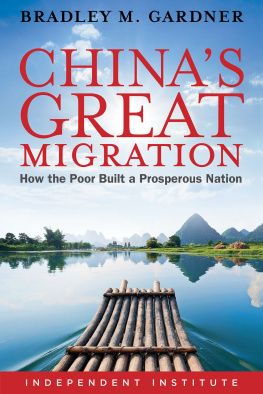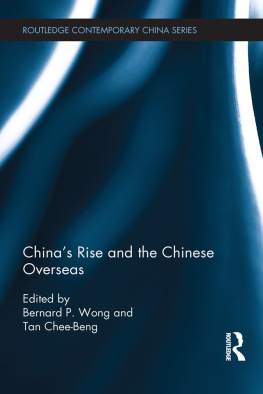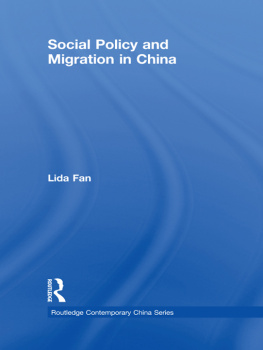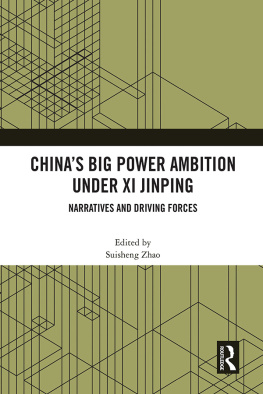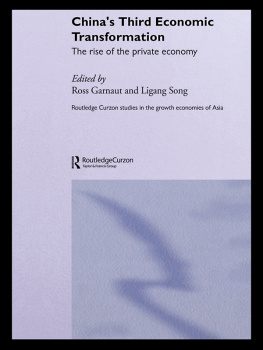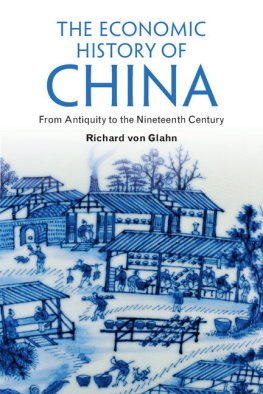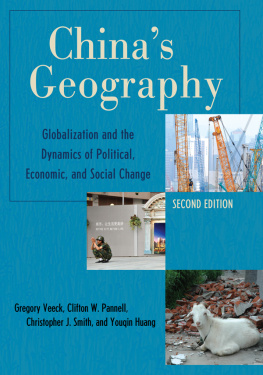Chinas Great Migration
Copyright 2017 by the Independent Institute
All Rights Reserved. No part of this book may be reproduced or transmitted in any form by electronic or mechanical means now known or to be invented, including photocopying, recording, or information storage and retrieval systems, without permission in writing from the publisher, except by a reviewer who may quote brief passages in a review. Nothing herein should be construed as necessarily reflecting the views of the Institute or as an attempt to aid or hinder the passage of any bill before Congress.
Independent Institute
100 Swan Way, Oakland, CA 94621-1428
Telephone: 510-632-1366
Fax: 510-568-6040
Email:
Website: www.independent.org
Cover Design: Shanti Nelson
Cover blue sky photo: Zazastudio 123rf.com
Cover bamboo rafting photo in Li River, GuilinYangshou China:
Alberto Rigamonti 123RF.com
Library of Congress Cataloging-in-Publication Data
Names: Gardner, Bradley, author.
Title: Chinas great migration : how the poor built a prosperous nation / Bradley Gardner.
Description: Oakland, California : Independent Institute, 2017. | Includes bibliographical references.
Identifiers: LCCN 2016042324 (print) | LCCN 2016043469 (ebook) | ISBN 9781598132229 (hardcover) | ISBN 9781598132236 (paperback) | ISBN 9781598132243 (ePub) | ISBN 9781598132250 (Mobi) | ISBN 9781598132267 (Pdf)
Subjects: LCSH: Rural-urban migrationChinaHistory. | Migration, InternalEconomic aspectsChinaHistory. | Economic developmentChinaHistory. | Social changeChinaHistory. | ChinaEconomic conditions1949- | ChinaSocial conditions1949
Classification: LCC HB2114.A3 G27 2017 (print) | LCC HB2114.A3 (ebook) | DDC 307.2/40951dc23
LC record available at https://lccn.loc.gov/2016042324
Contents
Acknowledgments
THIS BOOK WOULD not have been possible without the contributions and help of numerous people. At the top of this list should be David J. Theroux, Roy M. Carlisle, Alexander Tabarrok, William F. Shughart II, and the others at the Independent Institute who supported this project and helped develop it into what you read here.
Much of the content in this book stems from research projects I worked on for the Economist Intelligence Unit, and I am indebted to my supervisors, Alexander Van Kemenade and Victoria Lai, for much of my understanding of how China works. I also owe a debt of gratitude to J. C. Ning, who gave me my first job in China and was indulgent of my interests and larger story ideas. Additional thanks to Jagadish Upadhyay for providing comments on the completed manuscript.
Countless people in China helped me research this book. I would like to particularly thank Zhang Hong, Helen Feng, Zeo Niu, Meng Xiaodong, Jia Lingmin, Weng Wenbiao, and the Wenzhou businesspeople who will remain nameless. I would also like to thank Kam Wing Chan at the University of Washington for help wrapping my head around Chinas migration data.
And, of course, Zdenka, for twelve years together, three continents, two beautiful daughters, and many late nights typing.
This book is dedicated to my grandfather, Archie Lee Frazer, who witnessed the Chinese Civil War firsthand as a US soldier in Chongqing during the last months of World War II. He was born in rural Missouri in 1923, and spent several years, both before and after the war, traveling the country looking for work. Over fifteen years, he lived in Chicago, Memphis, and San Francisco, working as a taxi driver, a building manager, a dispatching agent, and a tax adviser.
He eventually found a job as a manager with the multinational construction firm Bechtel, where he earned enough to buy a house and raise seven children in what would later become Silicon Valley. He celebrated his 92nd birthday while this book was being written and the birth of his fourth great-grandchild. I hope this book contributes to other migrants having the same opportunities and the same successes that he had.
Introduction
OVER THE PAST three decades, the world has become a much better place for the poor. Between 1990 and 2015, the percentage of the world living in absolute poverty declined by 72 percent despite the worst economic crisis since the Great Depression. Today hundreds of millions of people have access to opportunities that would have been denied to them a generation agoopportunities to invest in themselves and improve the lives of their families and their children.
The scale of this success was almost entirely unexpected. In 1990, two out of every five people in the world lived in poverty, and in Latin America and Africa the situation was getting worse. Ten years later, the decline in poverty was visible, but still few people predicted the scale of progress that would be seen over the next decade. The United Nations Millennium Development Goals, announced in 2000, aimed to lower the developing world poverty rate by half by 2015, a far more modest improvement than what would eventually be achieved.
Why this happened is still a matter of some debate. The decline in poverty has happened globally, in countries with varying economies and political environments. Each affected country benefited from different local reforms, as well as changes to the global economy brought about by new technologies and globalization. Untangling which of these changes contributed the most to the success of a countrys poor, and which had negligible or negative long-term effects, is often both challenging and politically controversial. Were Latin Americas poor helped more by reforms to social services that helped fight income inequality, or by a succession of market-friendly political leaders that opened the continent to the global economy?
At the center of this debate is China. From 1981 to 2011, the size of the Chinese population living in absolute poverty declined by 753 million peoplea number roughly twice the population of the United States. The Chinese economic miracle accounted for 50 percent of the total decline in poverty levels globally, and almost the entirety of the net decline in poverty levels, as population growth in other countries ate away at their progress. If we want to understand how the world has been so successful at reducing poverty, and how we could move forward to eliminating poverty, it is important to understand what China has done to transform itself from the worst performing major economy in the world to a middle-income economy and a global economic power.
Unfortunately, Chinas growth story inspires as much, if not more, debate as other developing countries. On the one side, Chinas free market reforms have been substantial. The Chinese economic miracle happened alongside Chinas transition from a brutally enforced communist system to a market-based economy. Chinas first wave of growth in the 1980s was spurred by the decollectivization of agriculture and the legalization of private employment. In the 1990s, China moved from a primarily state-controlled economy to a primarily private economy, with the states share of employment dropping from 60.5 percent in 1998 to 19.4 percent by 2010. These private sector companies would quickly come to dominate global export markets for light-manufactures and electronics, passing on wealth to their workers who invested in new homes and new businesses.
But past these points, the typical Washington consensus argument runs into trouble. While employment has been increasingly dominated by the private sector, the Communist Party still controls many strategically important industries, including finance, telecoms, oil, coal, and steel. Chinese farmers still dont have full ownership of the land they work, and Chinas booming real estate market is tied up with Chinas byzantine land-use regulations and its backward financial markets. For some, these distortions are indications of an intelligent guiding hand that has allowed China to succeed where other developing countries have failed. For others, they are a sign that Chinas economy is a Potemkin village, full of empty high-rises and factories producing for nonexistent consumers, waiting for financial reality to catch up to it.

